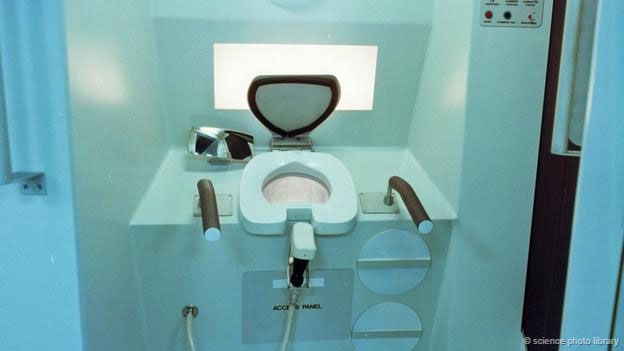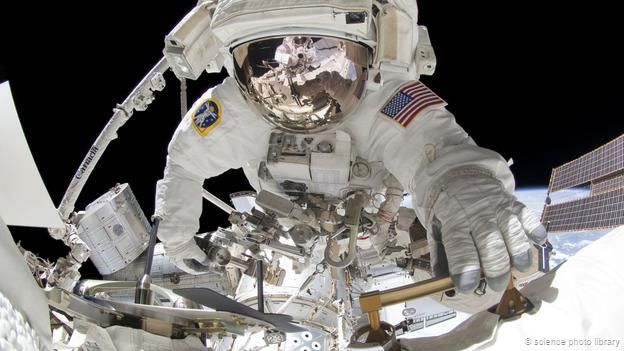如何解决宇航员的尴尬问题? - BBC理查德·胡里汉(2023年6月19日)

珍妮弗·普鲁特的工作意味着宇航员尿液中有更多的水能够被再次饮用。(图片来源:理查德·胡里汉)
珍妮弗·普鲁特(Jennifer Pruitt)的职位可能是美国航空航天局(NASA),甚至是全球航天工业中最有意思的一个,她是尿液处理首席工程师。
“这一头衔是我喜欢这个工作的其中一个原因,”她自豪地说道,“世界上并没有很多人从事这项技术。”
普鲁特在马歇尔太空飞行中心(Marshall Space Flight Center)工作,负责国际空间站的水回收系统。这一中心位于阿拉巴马州(Alabama)的亨茨维尔市(Huntsville)。她的目标是设计出最高效的方式来从宇航员的尿液中提取出饮用水。
尿液中含有大约95%的水(其余部分由人体废弃的化学物质构成),因此如果从两个国际空间站的厕所中可以循环使用更多的水,那么从地球上以昂贵成本携带饮用水到空间站的量就会少很多。
普鲁特实验室外的接待区里布置着一个小小的关于尿液的展览。装着尿液的广口瓶依次在架子上排列展示:从无比正常的浅黄色,到棕色,再到令人不安的黑色。
复杂的处理过程
令人不安的是,贴有“美国预处理尿液”标签的广口瓶中的尿液要比贴有俄罗斯标签的颜色浅得多。
这说明了俄罗斯尿液的什么问题呢?

(图片来源:Science Photo Library)
“俄罗斯人没有问题,”普鲁特向我们保证道,“他们就像其他人一样撒尿。”事实上,那些黑墨水般的液体不是单纯的俄罗斯宇航员的尿液,而是已经加进了处理程序中所需要用到的一些成分。
“当宇航员使用卫生间时,我们不能听凭尿液自己进入系统中,”普鲁特解释道,“我们必须在其中加入额外的外学物质,来阻止尿液的分解,并防止细菌滋生。”
这一预处理步骤只是美国航空航天局开发的空间站厕所水回收系统复杂流程的第一步。回收的饮用水除了从尿液回收的之外,还包括了从国际空间站空气中过滤出来的水分,其中大部分是宇航员的汗水。据美国航空航天局估计,平均每位宇航员在长达一年的任务中需要喝下730升回收自尿液和汗水的水。
“盐粒”的破坏
但美国航空航天局也遇上了麻烦。
尽管对汗水的回收工作运营良好,绝大部分的汗水都顺利转变成了饮用水,尿液回收系统却表现得不如预期。在地球上的实验室中,它的运行效率大约在85%左右,仅仅损失15%的水。但在国际空间站的运行轨道上,只有75%的水被回收。
“在太空中,钙质会从宇航员的骨骼中析出,而我们之前没有意识到这些钙质会去哪里,”普鲁特说到,“我们后来发现许多钙质都排放到尿液中了。”
这意味着太空中的宇航员的尿液和工程师们在地面上研究的尿液拥有不同的化学成分。
“我们发现,由于那些以前没预期到的钙质,尿液会同预处理过程中的化学物质发生反应,生成硫酸钙,”普鲁特解释道,“一簇簇大颗的盐粒会堵住系统——基本会让它停止工作。”
你可以想象和其他五个人一起被困在一个距离地球400公里(250英里)的金属盒子中,并且还没有能用的厕所是多么恐怖的一件事。因为厕所被堵,国际空间站的宇航员不得不花费更多的时间来维护设备,而相比原计划,地球方面也不得不运送更多的水来。

改进这项技术意味着昂贵的补给任务可以携带更少的水上天。(图片来源:Science Photo Library)
但普鲁特的团队已经想到了解决方法。通过改变尿液预处理步骤中的化学成分,他们希望能够让国际空间站中的尿液回收系统变得更有效率。
为了测试最新化学调和物,普鲁特在马歇尔中心广阔的飞机停机棚中搭建了尿液处理器的复制品,在一张桌子上依次铺开。这个飞机停机棚是美国航空航天局用来设计和检测它的生命维持系统的。一幅悬挂在屋顶大梁上横幅告诉参观者,这一实验室“从1973年起就维持宇航员生命”。
压力与蒸馏
作为在国际空间站的尿液处理器的复制品,这一被拆解的复制品由一大团令人眼花缭乱的管道、水泵和电线构成,它们和一大罐尿液相连。这些尿液已经完成了预处理步骤,所以看上就像一听巨型可乐。伴随着机器的运作声,普鲁特告诉我这一处理器是怎么工作的。
“我们把所有的东西都水平放置,由此重力带来的影响可以忽略不计,”她解释道。“这个水泵采用和人类的食道同样的工作原理,压缩并推动在它周围的液体。”我们看到沿着一根透明的管道,尿液被挤压前行,通往系统中最大的一个圆缸,它和一个家用烤箱一般大小。这个容易连接着一根真空泵,可以抽出空气来减轻内部压力。通过降压,液体的沸点也同样降低了。这意味着不需要提供任何热量,水就可以被分离。
蒸馏后残余的液体还将被系统再度循环以提取最大数量的水分。加工过程的最终产物是一团浓缩的含盐沉淀物和纯净的饮用水。在太空,废料将被装进一艘冗余的补给舰,在返回地球的过程中在大气层中燃烧殆尽。水已经可以喝了。
“这是最干净的水,”普鲁特说道,“比我们在地球上喝到的任何水都干净。”
不过,在宇航员啜饮这些超级干净的水之前,它们还要被进一步加工来防止细菌滋生。这一过程包括添加碘,这使得国际空间站的水带有淡淡的药味。
“这没什么,”普鲁特说道,“习惯就好。”
再证明新的预处理配方不会造成任何堵塞后,美国航空航天局的工程师们将会在接下来的几个月中推出改良后的尿液饮用水回收系统。人们希望它在太空中回收水的效率将能大幅上升至在地球上的实验室中的水平。
与此同时,普鲁特的团队正在研发新的技术以让处理过程更为高效。
“虽然和尿液打了好几年交道,”她说,“这工作还是那么的有趣!”
(责编:友义)
Solving a space station’s toilet-shaped problem - By Richard Hollingham
Jennifer Pruitt has one of the most interesting job descriptions in Nasa, if not the entire space industry.
Pruitt is Lead Engineer for Urine Processing.
“The title is one of the things I like about my job,” she says proudly. “There are not many people around the world working on this kind of technology."
Pruitt works at the Marshall Space Flight Center in Huntsville, Alabama on the International Space Station’s (ISS) water recovery system. Her goal is to devise the most efficient way to extract drinking water from astronauts’ urine.
Urine contains around 95% water (the rest is made up of the body’s waste chemicals) so the more water that can be recycled from the two ISS space toilets, the less that needs to be brought up from Earth on costly supply-runs.
In the reception area outside Pruitt’s laboratory, there is a small exhibition area devoted to urine. Jars of the stuff are displayed on a shelf – they range in colour from a perfectly regular-looking light yellow, through brown to a disconcerting black.
Sophisticated process
Disturbingly, the jar labelled “American pre-treated urine” is a much lighter colour than the jar with the Russian label.
What does this say about Russian urine?
“There’s nothing wrong with the Russians,” says Pruitt reassuringly, “they still pee like everyone else.”
The dark inky liquid is not, in fact, Russian urine but Russian urine with ingredients added as part of the treatment process.
“When the astronauts use the bathroom, we can’t let the urine go through the system by itself,” Pruitt explains. “We have to put some extra chemicals in it to stop the urine breaking down, as well as preventing the growth of bacteria.”
This pre-treatment is the start of a sophisticated process Nasa has developed to recycle water from space toilets. This recovered water is combined with moisture filtered from the air in the ISS – mostly from astronauts’ sweat – to be turned back into drinking water. The space agency estimates that the average astronaut will drink 730 litres of recycled urine and sweat during a year-long mission.
Salty sabotage
But Nasa has a problem.
Although the sweat recovery part of the equation is working well – with almost all moisture returning to drinking water – the urine recycling system has not been performing to expectations. In the lab on Earth it runs at around 85% efficiency – with only 15% of water lost. In orbit on the ISS, only 75% of water is recovered.
“In space, calcium leaches out of astronauts’ bones and one of the things we didn’t think about before is where that calcium went,” Pruitt says. “We found out that a lot of it comes out in their urine.”
This means an astronaut’s urine in space has a different chemical composition to the urine – donated by Marshall employees – the engineers were working with on the ground.
“We found that, because of the extra calcium, the urine was reacting with the pre-treatment chemicals to form calcium sulphate,” explains Pruitt, “Big salt clusters were gunking up the system – basically it stopped working.”
You can only imagine the horror of being trapped in a metal box 400 kilometres (250 miles) above the Earth with five other people and no working toilet. As a result of these blockages, ISS astronauts have had to spend extra time on maintenance and more water has had to be transported from Earth than originally planned.
But Pruitt’s team has come up with a solution. By changing the chemical composition of the urine pre-treatment, they hope to get urine recycling on the ISS working more efficiently.
To test the latest chemical concoctions, Pruitt has a working replica of the urine processor spread out along a table in the vast hangar at Marshall where Nasa devises and tests its life support systems. A banner hanging from one of the roof girders informs visitors that the lab has been “keeping astronauts alive since 1973”.
Pressure and distillation
The urine-processing machine – a deconstructed replica of the one in orbit – consists of a bewildering jumble of tubes, pumps and wires attached to an enormous jar of urine – pre-treated so it resembles a super-sized cola. As the machine gurgles away, Pruitt talks me through how it works.
“We have everything laid out horizontally so we can discount any effects of gravity,” she explains. “The pumps we use work the same way your oesophagus does – constricting and pushing the fluid around.”
We watch as urine is squeezed along one of the transparent tubes towards the largest cylinder in the system, around the size of a domestic oven. This tank has a vacuum pump attached that sucks out the air to lower the pressure inside. By reducing the pressure, the boiling point of the liquid also drops. This means water can be separated without applying any heat.
The remaining liquid left after distillation is cycled back around the system to extract the maximum amount of water. The final products of the process are a concentrated salty sludge of waste and pure drinking water. In space the waste would be packed into a redundant supply ship and burned up in the Earth’s atmosphere during its return to Earth. The water is ready to drink.
“It’s the cleanest water,” says Pruitt, “cleaner than anything we’ll drink on Earth.”
However, before the astronauts get to sup this super-clean water it is further treated to prevent the growth of bacteria. This involves adding iodine, which gives water on the ISS a slight medicinal taste. “It’s not bad,” says Pruitt. “You just have to get used to it.”
Having proved the new pre-treatment formula no longer causes blockages, Nasa engineers will be introducing the revised system over the coming months. The hope is that it should bump up water recovery rates in space to the same efficiencies they are seeing in the lab on Earth.
In the meantime Pruitt’s team is developing the technology to make the process even more efficient.
“Even when you’re in urine for several years,” she says, “it’s still fun!”